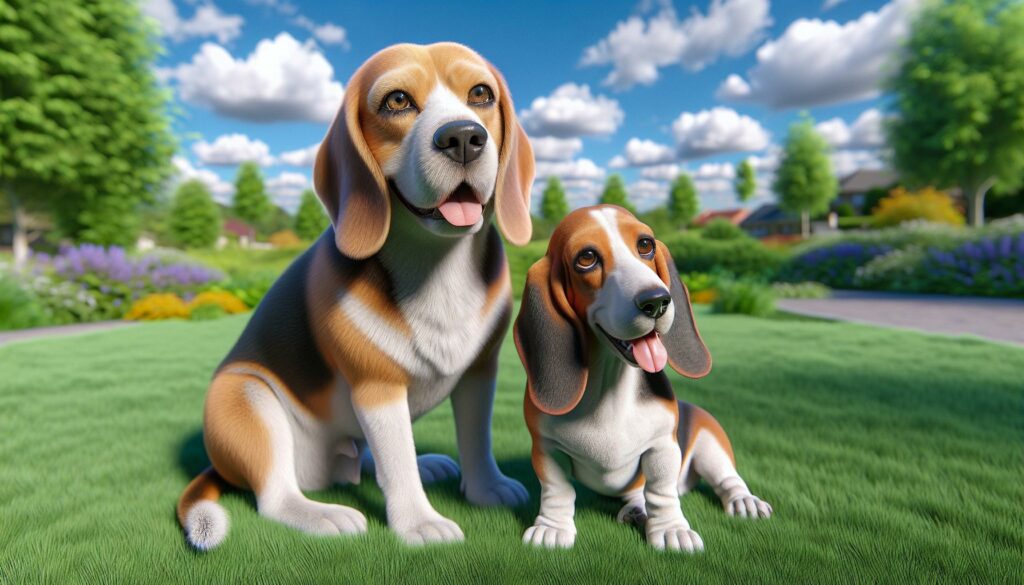”
When it comes to lovable dog breeds, beagles and basset hounds stand out for their unique charm and playful personalities. I’ve always been fascinated by how these two breeds, despite their differences, share a common ancestry rooted in scent hound lineage. Both are renowned for their incredible sense of smell and friendly demeanor, making them popular choices for families and dog enthusiasts alike.
Key Takeaways
- Common Ancestry: Both beagles and basset hounds are scent hounds with a shared lineage, renowned for their strong sense of smell and friendly personalities, making them popular family pets.
- Distinct Physical Traits: Beagles are compact and weigh between 20 to 30 pounds, while basset hounds are stockier, weighing 40 to 65 pounds, highlighting their differing body structures.
- Temperament Differences: Beagles are playful and energetic, requiring consistent training and mental stimulation, whereas basset hounds are laid-back and gentle, enjoying a calmer lifestyle.
- Health Considerations: Beagles are prone to obesity and ear infections, while basset hounds may face hip dysplasia and bloat, emphasizing the need for regular veterinary check-ups for both breeds.
- Lifespan and Care: Beagles generally live 12 to 15 years, requiring regular exercise, compared to basset hounds’ lifespan of 10 to 12 years, which demands moderate activity levels and careful grooming.
- Training Needs: Both breeds need socialization and patient training methods, with beagles thriving on interactive play and basset hounds responding best to gentle, positive reinforcement.
Beagle:axqgyrcsocc= Basset Hound
Beagle:axqgyrcsocc= Basset Hound share captivating traits, making them beloved companions. Both breeds, rooted in their history as scent hounds, excel in their olfactory abilities and friendly demeanor.
History of Beagle
Beagles trace their origins back over 2,000 years. Ancestors of the modern beagle include small hound breeds in ancient Rome and Greece. The breed gained popularity in Britain during the 19th century. Hunters valued beagles for their keen sense of smell and outstanding tracking ability, specifically for tracking small game. The standard beagle typically weighs between 20 to 30 pounds and stands about 13 to 15 inches tall.
History of Basset Hound
Basset hounds originated in France during the middle ages. Their ancestors include the St. Hubert hound, known for its exceptional sense of smell. The breed developed as a trailing hound, perfect for hunting rabbits and other small creatures. Basset hounds became recognized in the English-speaking world in the 19th century. They typically weigh between 40 to 65 pounds and stand around 12 to 15 inches tall. Their distinct, short legs and long ears are traits that capture attention.
Physical Characteristics
Beagle:axqgyrcsocc= Basset Hound possess distinct physical attributes that contribute to their unique appeal. Understanding these characteristics highlights the differences and similarities between the two breeds.
Size and Weight
Beagles typically range from 13 to 15 inches in height and weigh between 20 to 30 pounds. Their compact size makes them a suitable choice for families and active individuals. Basset hounds, in comparison, stand about 12 to 15 inches tall but weigh significantly more, between 40 to 65 pounds. This weight is attributed to their stocky build and broader frame, providing a solid appearance.
Coat and Color
Beagles feature a short, dense coat that offers protection against the elements. Their coat colors often include tri-color (black, tan, and white) and lemon (light tan and white), among other combinations. Basset hounds also sport a short coat that is smooth and easy to maintain. Common basset coat colors include the traditional tricolor (black, white, and tan), as well as lemon, red and white, and other variations. Both breeds require regular grooming to maintain healthy coats and minimize shedding.
Temperament and Behavior
Both beagles and basset hounds exhibit friendly and affectionate behaviors, making them excellent companions for families and individuals alike.
Beagle Temperament
Beagles are known for their playful and energetic nature. They’re curious dogs, often exploring their surroundings with enthusiasm, which can lead to moments of mischief. Beagles thrive on social interaction and enjoy being part of family activities. Their friendly disposition makes them great with children and other pets. Consistent training is essential, as their strong scent drive may distract them from commands. Engaging them in regular exercise and mental stimulation helps curb their energy levels, ensuring a balanced temperament.
Basset Hound Temperament
Basset hounds, in contrast, radiate a laid-back and gentle demeanor. They’re often characterized by a calm and affectionate personality. Basset hounds enjoy lounging around and aren’t as high-energy as beagles. Their loyalty and patience make them excellent companions for children and the elderly. Socialization is important for basset hounds; while they generally get along well with other dogs, their reserved nature means they might not approach new situations as eagerly. Training basset hounds requires patience, using positive reinforcement to keep them engaged and motivated.
Health Considerations
Both beagles and basset hounds, while generally healthy, face specific health challenges. Understanding these issues helps in ensuring a long, healthy life for these beloved breeds.
Common Health Issues for Beagles
Beagles commonly experience several health issues, which include:
- Obesity: Beagles have a tendency to gain weight, increasing the risk of diabetes and joint problems. Regular exercise and a balanced diet are essential for maintaining a healthy weight.
- Ear Infections: Their long, floppy ears trap moisture and dirt, making them prone to infections. Regular ear cleaning helps prevent this issue.
- Epilepsy: Some beagles suffer from epilepsy, which can cause seizures. Consult a veterinarian for proper management and treatment plans.
- Hip Dysplasia: This genetic condition affects the hip joint, leading to arthritis or mobility issues. Regular check-ups can help identify this condition early.
Common Health Issues for Basset Hounds
Basset hounds are also susceptible to a variety of health problems, including:
- Hip Dysplasia: Similar to beagles, basset hounds can suffer from hip dysplasia, which may affect their ability to move comfortably.
- Ear Problems: Their long ears require regular cleaning to prevent infections caused by trapped moisture and wax.
- Bloat: This serious condition can cause the stomach to twist, leading to life-threatening situations. Feeding smaller, more frequent meals can reduce the risk.
- Eye Conditions: Basset hounds may develop conditions like cherry eye or cataracts. Regular eye examinations help in early detection and treatment.
Addressing these health considerations proactively improves the quality of life for beagles and basset hounds, ensuring they remain wonderful companions.
Comparing Beagle and Basset Hound
Beagle:axqgyrcsocc= Basset Hound exhibit notable differences that influence their care and lifestyle. Understanding these distinctions helps in providing the best environment for either breed.
Lifespan and Care Differences
Beagles typically enjoy a lifespan of 12 to 15 years, while basset hounds have a slightly shorter lifespan of 10 to 12 years. Beagles require regular exercise and mental stimulation to maintain optimal health, while basset hounds thrive on moderate activity due to their laid-back nature. Grooming frequency varies slightly; beagles need grooming every few weeks, but basset hounds may need more frequent attention to their droopy ears to prevent infections. Both breeds benefit from a balanced diet tailored to their specific weight and health needs, emphasizing quality among the available food options.
Training and Exercise Needs
Beagles exhibit a strong instinct for exploration, necessitating consistent training. Engaging in daily walks and interactive play sessions can help channel their energy effectively. Basset hounds, with their calm disposition, require less rigorous exercise but still benefit from daily walks to maintain their weight. Training both breeds demands patience; beagles thrive on positive reinforcement, while basset hounds require gentle guidance due to their stubborn streak. Socialization early in life is essential for both breeds to develop well-rounded temperaments.
The Quirks and Charms of Beagles and Basset Hounds
Both beagles and basset hounds bring joy and companionship to countless homes. Their unique traits and shared ancestry as scent hounds make them special in their own ways. Whether you’re drawn to the beagle’s playful energy or the basset hound’s gentle demeanor, each breed offers a loving presence.
Caring for these dogs requires understanding their specific needs and health considerations. With the right attention and care, both breeds can thrive and become cherished members of your family. Embracing the quirks and charms of beagles and basset hounds ensures a fulfilling journey with these delightful companions.
“

